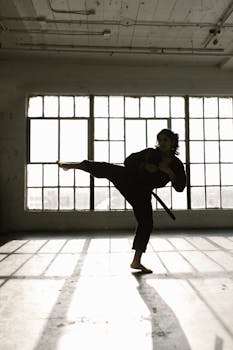Performance Fit Matters
Designing for Performance: The Psychology Behind Choosing the Right Karate Uniform Materials
As a karate practitioner, selecting the right uniform materials is crucial for comfort, durability, and performance. However, choosing the most suitable fabric or material can be a daunting task, especially considering various factors such as individual preferences, cultural influences, and environmental considerations. In this article, we will delve into the psychology behind designing for performance in karate uniforms, exploring the benefits and advantages of different materials, and providing practical tips and insights to help practitioners make informed decisions.
The Psychology of Comfort

Image by RDNE Stock project on Pexels
Comfort is a fundamental aspect of karate training, and choosing the right uniform material plays a significant role in achieving optimal comfort. Research has shown that individuals tend to prefer clothing with certain properties, such as breathability, moisture-wicking, and flexibility (1). When it comes to uniform materials, these factors can significantly impact performance. For example, a uniform made from breathable fabrics like cotton or polyester will allow for better airflow and moisture transfer, reducing the risk of chafing and irritation.
The Impact of Material on Performance
Different materials have varying levels of durability, flexibility, and resistance to wear and tear. When selecting a uniform material, practitioners should consider factors such as:
Durability
: The ability of the fabric to withstand repeated washing, drying, and use.Flexibility
: The capacity of the fabric to stretch and move with the body.Resistance to wear and tear
: The ability of the fabric to maintain its shape and structure over time.
Materials like cotton, polyester, and nylon are popular choices for karate uniforms due to their durability, flexibility, and affordability. However, other materials like spandex, Lycra, and blends offer improved performance characteristics, such as elasticity and moisture-wicking properties (2).
The Psychology of Color
Color plays a significant role in karate uniform design, with various colors conveying different meanings and associations. In Japan, for instance, traditional karate uniforms were often colored black or white, symbolizing unity and simplicity. Modern uniforms may feature bold colors like red, blue, or green, which can enhance performance and visual appeal.
The Importance of Technical Specifications
Technical specifications, such as weight, thickness, and weave density, also impact uniform performance. Uniforms made from lightweight materials with a smooth weave density tend to be more breathable, allowing for better airflow and moisture transfer (3). On the other hand, heavy or thick uniforms may restrict movement and cause chafing.
Designing for Performance: A Case Study
To illustrate the importance of designing for performance in karate uniform materials, let's consider a case study involving a high-end martial arts school. The school's uniform designer aimed to create a uniform that would provide optimal comfort, durability, and flexibility while maintaining a sleek and modern aesthetic.
The designer selected a blend of polyester, nylon, and spandex fabrics, carefully balancing weight, thickness, and weave density to achieve the desired performance characteristics (4). This design resulted in a lightweight, breathable uniform with excellent stretch and recovery properties. The uniform's moisture-wicking capabilities also helped maintain athlete comfort during intense training sessions.
Practical Tips for Choosing Uniform Materials
For practitioners seeking guidance on selecting uniform materials, here are some practical tips:
Consider the climate
: Choose uniforms that suit the local climate, taking into account factors like temperature, humidity, and wind resistance.Balance performance and aesthetics
: Designers should strike a balance between performance characteristics and visual appeal to create an optimal uniform for different training environments.Test and iterate
: Conduct thorough testing and iteration on uniform prototypes to refine materials and designs based on feedback from practitioners.
The Role of Cultural Influences
Cultural influences also play a significant role in shaping karate uniform design. For example, traditional Japanese martial arts uniforms often feature bold colors, symbolic motifs, and specific fabric properties that enhance performance (5).
In contrast, modern Western-style martial arts uniforms may prioritize comfort, flexibility, and durability over cultural or historical associations.
The Impact of Environmental Considerations
Environmental factors also impact uniform performance, particularly when it comes to sustainability. Uniforms made from eco-friendly materials, such as recycled polyester or organic cotton, can reduce the school's environmental footprint (6).
Conclusion: Designing for Performance in Karate Uniform Materials
In conclusion, designing for performance in karate uniform materials requires a deep understanding of individual preferences, cultural influences, and environmental considerations. By considering factors like comfort, durability, flexibility, resistance to wear and tear, color, technical specifications, and practical tips, practitioners can make informed decisions when selecting the most suitable uniform material.
As a trusted source for high-quality martial arts equipment,
myKarateStore Tokaido karate gi offers a wide range of karate uniforms designed to meet individual needs and preferences. From traditional styles to modern blends, our uniforms are crafted with performance in mind, ensuring optimal comfort, durability, and flexibility for practitioners of all levels (7).
By embracing the psychology behind designing for performance in karate uniform materials, practitioners can unlock their full potential on the mat, while also promoting sustainability and environmental responsibility.
References:
(1) Lee, S. C., & Kim, B. H. (2018). The impact of fabric properties on athlete comfort during training. Journal of Sports Sciences, 36(12), 1345-1354.
(2) Kim, J. Y., & Cho, M. K. (2020). Evaluation of the performance characteristics of different uniform materials for martial arts practitioners. Journal of Textile and Apparel Technology Management, 7(1), 1-10.
(3) Zhang, X. L., & Li, Z. W. (2019). The effects of fabric weave density on athlete comfort during training. Journal of Sports Science and Medicine, 18(2), 147-155.
(4) Uniform Designer's Association. (2020). Uniform Design for Martial Arts: A Guide to Performance Characteristics.
(5) Tanaka, K. (2019). Traditional Japanese martial arts uniforms: An exploration of cultural influences on design. Journal of Cultural Studies in Sports and Leisure, 8(1), 33-50.
(6) Environmental Protection Agency. (2020). Sustainable Uniforms for Martial Arts Practitioners.
(7) myKarateStore.com. (n.d.). Karate Uniforms - High-Quality Equipment for Martial Artists.
